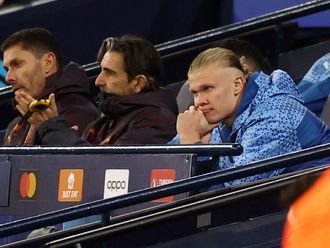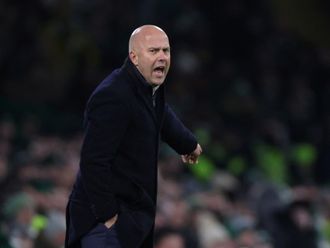
If I mentioned the name Patrick O’Connell to you, the chances are it wouldn’t register even a flicker of acknowledgement.
But, given what the Irishman achieved in both English and Spanish football during the early part of the last century, that’s incredibly unusual.
You see, not only was O’Connell a former Manchester United captain, but he also led Real Betis to their only La Liga title and latterly became known as “the man who saved Barca”.
He died destitute and penniless in London in 1959 and lies in an unmarked pauper’s grave in St. Mary’s Catholic Cemetery, Kensal Road, in the north west of the capital.
His final resting place is certainly not in keeping with the astonishing success he brought to the many clubs that he both played for and managed.
And that is exactly the reason why there is now a campaign to raise money to build a memorial more befitting of the man.
Some of the greatest players to have ever graced the game — Johan Cruyff, Franz Beckenbauer, Paolo Maldini, Luis Figo and David Beckham — have, at the very least, given signed shirts for the fund to auction. And ex-Republic of Ireland international, and now Sky Sports Spanish football pundit, Gerry Armstrong is a proud ambassador for the fund.
It’s perhaps in Ireland where we should begin the story of “Don Patricio”.
O’Connell was born in County Westmeath in March 1887, but grew up on the mean streets of Dublin, where his footballing prowess was quickly recognised.
Frankfort, founder members of the League of Ireland, were one of a handful of local clubs where the young O’Connell plied his footballing trade until Belfast Celtic came calling and offered him a professional contract.
It was the beginning of a roller-coaster journey, both in a professional and personal sense.
A robust player, he excelled in the wing-half and centre-half roles, and in 1909 Sheffield Wednesday would come calling, taking 22-year-old O’Connell and teammate Peter Warren to England.
It would prove to be a disastrous move, but his three seasons of disappointment ended when he signed for Hull City — already the third club of a fledgling playing career.
Whilst his tenure on Humberside was more enjoyable, O’Connell still found regular games hard to come by, and only his performances for the Irish national team gave him anywhere close to the kudos he desired.
It was whilst playing on the international stage that Manchester United became interested and the Red Devils concluded a £1,000 transfer in May 1914, just three months before the First World War broke out.
O’Connell captained the side throughout the following season but became embroiled in, although never convicted for, one of the most sensational football scandals of the time.
On April 2, 1915, United visited rivals Liverpool in a match they had to win to avoid relegation. What followed was an insipid and contrived display by both sides that gave rise to suggestions of impropriety. Certainly the many supporters in attendance had the feeling that something was amiss and let the players know their feelings accordingly.
Unusual betting patterns — yes, even all those years ago — led to an FA investigation that eventually concluded, with the help of testimony from certain players that had been approached, that seven players (three from United, four from Liverpool) had been in cahoots to get the match fixed in some way.
O’Connell escaped punishment and played two more matches for the Red Devils before the Football League suspended all footballing activity because of the war. Although registered as a Manchester United player throughout, O’Connell would only guest for Clapton Orient, Rochdale and Chesterfield until the war ended.
It was 1919 before any sort of league football resumed and, despite certain changes to the league set-up, including an expansion from 20 to 22 teams, O’Connell was unable to find a single English club to take him.
A brief sojourn to Dumbarton and the Scottish League was a welcome respite, with Ashington, an area synonymous with Bobby and Jack Charlton, the final stop of a chequered playing career.
The north-east club became the grounding for an incredibly successful managerial career — he was player/manager in his second season — but it was at this juncture that his personal life was at breaking point.
Sue O’Connell, wife of Patrick’s grandson Mike, told Gulf News: “He started his managerial career as a player/manager there [Ashington], and in the 1920s it was a way of escaping the pits. Unfortunately, around the same time his ‘difficult’ marriage finally collapsed.”
The breakdown of his relationship appeared to be the catalyst for Patrick to “disappear” and he would eventually resurface in Spain, where his legend is assured and where, even now, he is still spoken about in reverential tones.
In any event, the impact on the family at the time was marked. O’Connell’s wife Ellen, who had given up everything to be with him in England and who bore four children by him, was left with nothing.
Sue O’Connell went on: “He was a man who was very able but the marriage was very difficult. It suited him to leave at that point.”
O’Connell started the Spanish leg of his story at Racing Santander. Taking over from Englishman Fred Pentland, he took Racing to unprecedented success almost immediately. Five regional Spanish titles later and the club had the honour of being nominated as one of the founders of La Liga in 1928.
Two seasons in the Segunda (second) division with Real Oviedo followed, but it was at Real Betis, then known as Betis Balompie, where O’Connell really made his mark.
The Seville-based club were taken to the highest of heights by O’Connell. Three years after taking over, having already presided over a promotion, Betis were still in with a chance of winning La Liga on the last day of the 1935 season, a point ahead of Real Madrid.
A win against Racing Santander duly arrived and Betis were improbably crowned champions, still their only La Liga title to this day. It was achieved without any major stars in the side and, to put some sort of perspective on the achievement, Betis PR Julio Jimenez Heras told Gulf News recently: “We are very proud of the great Mr. O’Connell, always. He is very well known by our supporters and has a special place in our hall of fame.
“He was able to make a wonderful team with seven players from the Basque country and local players. They were a very strong and physical team, and our supporters still ‘live’ that championship, even though we celebrate the 80th anniversary in 2015.
“20 years after Mr. O’Connell left us, the club were aware of his finiancial difficulties so we played a match, Betis against players from the other teams in Spain, to raise money for him. He arrived to the centre circle with his hat on his head to receive an unbelievable atmosphere. The fans still loved him.
“It’s so sad that he died with nothing, but we are so happy to be involved with this fundraising effort to give him the grave that he deserves.”
Don Patricio was as popular off of the pitch as on it and the ladies’ man had no trouble acquainting himself with the opposite sex, even marrying a young Irish lady named Ellen, coincidentally the same name as his wife back in England.
Sue O’Connell remembers it being “an open secret” that Patrick had married again, despite not being divorced, and that “because he was professionally successful, if you kept your head down, you got away with it. It’s just how it was back then. Patrick was known as a bit of a lad by the family so it came as no surprise.”
Personal issues aside, the mighty FC Barcelona came calling and O’Connell took up their offer of management.
The Campionat de Catalunya was added to his list of honours, along with a narrow loss to Real Madrid in the Copa de Espana.
During the following season, the Spanish Civil War intensified and Josep Sunyol, the man credited with bringing O’Connell to the club, was shot and killed by General Franco’s troops.
Without regular fixtures to top up the club coffers, Barca’s financial position worsened significantly. Manuel Mas Soriano, a Catalan businessman who had escaped the troubles, invited O’Connell to bring the team to Mexico for a short series of exhibition type matches.
Six games later, and four more in New York on the way home, earned Barca in the region of $15,000 — a sum that took the club from the brink of bankruptcy back to a healthy financial position. It’s entirely correct to say that O’Connell’s persuasiveness in getting his players to buy into the project, and then having overseen a successful tour, had saved Barcelona from going out of business.
Although only four players returned to Catalonia, with the rest deciding to stay in exile elsewhere, O’Connell’s legend in Spain was secured.
After some time spent back in Ireland, O’Connell returned again to Spain during the Second World War, firstly at Betis and then to manage their great rivals Sevilla, a decision that sat surprisingly well with both the Betistas and Sevillistas.
Racing Santander, where it all started in Spain some 25 years before, was the last stop of an incredible career.
Some years later, in 1955, Patrick’s son Dan, after a tip-off from the Spanish national side playing in Ireland, decided to make the trek to Seville to track down the father he’d not seen for some 30 years, but he probably didn’t get the welcome he was expecting.
“He was only interested in how Manchester United were getting on,” explains Sue O’Connell, who has written a detailed and personal account of the grandfather her husband never met.
A flawed genius? Quite probably. But certainly one who deserves to rest in more appropriate surroundings.
For more information on the Patrick O’Connell Memorial Fund, to browse the extensive signed shirt collection (available for auction in Fenruary 2015) or to make a donation, visit www.pocfund.com
— The writer is a freelance journalist and Spanish football expert












